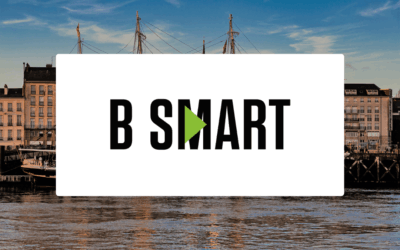Massive flows of spectators, dense traffic around stadiums, multifaceted logistics, physical and cyber threats… data and multidimensional hypervision, in real time, are strategic assets in the management of major sporting events. The Ministry of the Interior understood this and has given itself Suadeo to frame the Olympic Games, the largest global event. Interviewed by the IT Mag, the National Strategic Command Centre shared its experience and benefits on interdepartmental cooperation.
Excerpts from the article published on 03/02/2025 in Le Mag IT:
“Data also has a place in the organization of sporting events, especially to ensure their smooth running and safety. The uses are not necessarily visible to spectators and athletes.
Illustration with the Rugby World Cup and the Olympic Games in Paris 2024.
A “digital revolution” at the Ministry of the Interior
The two major international events were long-awaited. In order to guarantee security, the state set up a new entity in 2023, the National Strategic Command Center (CNCS). But it was also necessary to give it the organizational and technological means to fulfil its missions.
The answer was a “digital revolution” and a method revolution. This revolution took place at the Ministry of the Interior and its Digital Transformation Directorate (DTNUM), says Colonel Christophe Deshayes, Chief of Staff of the CNCS.
For major events, the state relies in principle on the CIC, the interministerial crisis cell, which reports to the Prime Minister. Operational management is generally entrusted to the Interior, in coordination with all departments.
The daily transfer of information to the national level is based on existing IS, especially at the prefecture level. The data are then consolidated at national level.
The model works, but could be improved. “We were missing an integration tool,” says CNCS. The solution had to reduce (or even eliminate) the re-capture of information, ingesting data from systems, but also from other sources.
Mission impossible at the Olympic Games without a new dedicated tool
The purpose? “Unify all the information, synthesize it through reporting, allow real-time analysis and much faster to clarify the situation for our authorities for decision making.” , explains Christophe Deshayes. (…)
The “unprecedented scale of this global event” has convinced us that we need to build our own a new digital ecosystem that allows for the integration of large volumes of data, from the Ministry of the Interior, but also from other ministries, open sources, organizer data, All for real-time tracking through the most contextualised information possible.
Colonel Christophe Deshayes to MagIT
The expectations of the trades in 2020 and 2021, made possible by the feedback from previous Olympiads, including the London Games, allowed DTNum to launch the reflection and development of the future platform built on the technology of the French publisher Suadeo. (…)
From 300 to 20 real-time geolocation data sets
“The trades were offered, the DTNum specified the need, and Suadeo set up its platform accordingly.” Iterations continued for 12 to 15 months, including after the Rugby World Cup in September and October 2023, the platform’s first “test match”.
For example, 300 data sets were used at the Oval Ball Festival. (…) For the Paris Games, 15 to 20 datasets were finally used, “but completely geolocated and in real time to allow decision-making.” (…)
During the transitional phase between the two sporting events, the platform was migrated to the sovereign cloud of the Ministry of the Interior (Cloud Pi) (…).
It was through an iterative process that the Data (or hypervision) platform was supplemented by applications necessary for collaboration and real-time information sharing. The result was a break in tooling (Excel, PowerPoint) and working method (department and interdepartmental). (…)
During the JO, more than 500 messages per day were captured and shared in what has become “the main collaborative tool of the ministry and all other departmental operators”. (…)
The information is filled in by the prefectures and then automatically aggregated into a report that can be used directly at a situation point. This document was previously done manually on PowerPoint.
With the platform, the construction of a point of situation works like a customizable assembly of components or legos. (…)
Each department and directorate has been able to use these HR features to educate their staff and manage their resources. (…)
Digital transformation with cultural change
For the CNCS Colonel, technology is only one part of the project.
“Developments and digital transformation have been used to support our cultural change: the consideration of the “reputational”, data integration, the ability to process large volumes of data and detect weak signals.”
Colonel Christophe Deshayes to MagIT
For him, the platform is part of a broader digital ecosystem that includes tools, but also “human and collective” at an interdepartmental level. As for the processes, they were built in parallel with the development of the platform. (…)
“Digital transformation was implemented for the largest international event a country could host. And it worked. (…) We demonstrated that the CNCS and its new digital ecosystem, its new way of working collectively, had worked, and even worked very well. […] We could go even further. But now is the time to do it.”
Colonel Christophe Deshayes to MagIT






